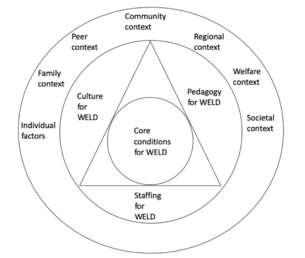There were two steps in the development of this model. To begin with, the co-researcher team engaged in conversations with young people with the indirect approach. Each member of the team analysed their data, and this led to the first set of findings, pertaining to the issues and barriers young people experience to education. The researchers could not all write about all the issues young people spoke about and so a range of different perspectives are reflected in the papers, and these may not be comprehensive. Dialogical workshop activities at both of the writing seminars were used to develop a fuller list of all the issues that had been heard from the young people. These were collated and are listed below:
• Bullying – poor peer relationships
• Poor teachers relationships
• High expectations
• Home issues (drugs, violence, separation, foster care, divorce, neglect)
• Homelessness
• Moving homes and schools
• Learning needs (dyslexia and ADHD)
• Mental health issues
• Social, racial and gender biases
• Sense of not fitting in
• Importance of social arenas (home, peer, school)
• Thriving and resilience
• Moving homes and schools
• A wide range of external and social barriers to learning.
The second step involved the co-researchers moving from the problem frame (what are the issues?) to a solution frame (what might address these issues?). An additional layer of interpretation was needed here as we each drew on our prior experience, professional training, knowledge and expertise to suggest factors that could address the issues raised by the young people. In some instances young people themselves stated what they wanted, e.g. “the best teachers listen to you and give you time”, but the turn to solutions was often grounded in implicit assumptions about what would address the issues they brought up. We collated all the ideas that were noted in findings and in research group discussion notes into the final framework.
The framework is shown below is a set of guiding principles to be adopted and tailored into a range of settings, further information about the model can be found in the book associated with the project.

This intellectual output feeds into and draws from the content and approach taken in intellectual outputs O2 & O6. This interdependency between the models enables us to share our knowledge and approach whilst also incorporating the empirical data produced for intellectual outputs O4, O5 & O8 and tailoring it for the needs of specific beneficiaries.
Elements innovation:
- Whilst models exist to improve literacy / awareness of the impact of characteristics which produce social inequalities (age, disability, ethnicity, gender, race, sexuality) this framework is unique in its exclusive focus on the conditions that promote success in Further and Higher Education for young people who have experienced challenging circumstances.
- The model was informed by student co-researchers who produced, analysed and wrote up empirical data collected with young people. Many of the students and young people had experienced difficult personal and social circumstances or had negative school experiences alongside peers who had not.
Expected impact:
This framework, alongside the equalities literacy framework, will:
- Enable HEI’s to address inequality by improving their response to and engaging with students who experience challenging circumstances.
- Improve student recruitment within marginalised communities who are often under-represented within HEI’s.
- To improve student support systems, processes and retention rates within non-traditional universities who offer vocational/ professional programmes.
- To improve student mental health, well-being and self-esteem.
- To improve interpersonal relationships between students and HEI personnel.
Transferability:
- The model will can be applied to all HEI systems and processes within the EU.
- The model can be incorporated into the content of existing equality and diversity, anti-oppressive practice, safeguarding and child protection and study skills modules.
- The model can be used as a critical reflection or self assessment tool by HEI’s wishing to understand the extent to which they support young people.
- The model can be produced as stand-alone module on programmes that focus on young people and marginalisation.